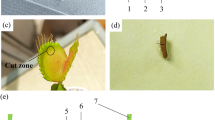Abstract
The ultrasonic scalpel has a number of excellent properties; however, its use in in vivo surgery is limited since the scalpel is not flexible enough. Changing the mechanism of ultrasonic vibration can allow the ultrasonic scalpel to bend. This paper reveals the mechanism of vibration generation of leaf-cutting ants, which is based on the microstructural and mechanical properties of special organs that produce the vibrations. Microstructural characteristics of cross-sections of the vibratory organ of Atta cephalotes were observed using scanning electron microscopy. It was found that the scraper perfectly matches the file plate dorsoventrally; however, the file teeth cannot catch the scraper. An exploration of the kinematics of the file-scraper device was subsequently carried out to reveal a face-to-face contact mode, facilitating a gentler engagement process. For the first time, the mechanism of vibration generation of leaf-cutting ants was investigated using a laser micrometer and high-speed camera. Results reveal the file-scraper device significantly amplifies the input frequency by 125 times, and magnification depends mainly on the tooth spacing and speed of engagement. Finally, nanoindentation tests were performed on file and scraper samples. The results show that they have similar mechanical properties, which greatly reduces friction and wear. This paper may provide theoretical guidance for the development of bionic vibration generators.
Similar content being viewed by others
References
Sibbons P D, Southgate A. Comparison of wound-healing and tissue effects using the Gyrus PlasmaKnife with monopolar, Coblation, and Harmonic Scalpel methodologies. Comparative Clinical Pathology, 2006, 15, 17–26.
De S, Rosen J, Dagan A, Hanaford B, Swanson P, Sinanan M. Assessment of tissue damage due to mechanical stresses. International Journal of Robotics Research, 2007, 26, 1159–1171.
Rosen J, Brown J D, De S, Sinanan M, Hannaford B. Biomechanical properties of abdominal organs in vivo and postmortem under compression loads. Journal of Biomechanical Engineering, 2008, 130, 021020.
Amaral J F. The experimental development of an ultrasonically activated scalpel for laparoscopic use. Surgical Laparoscopy & Endoscopy, 1994, 4, 92.
Ponsky J L. Complications of laparoscopic cholecystectomy. American Journal of Surgery, 1998, 12, 291–293.
Hansen O H, Håkansson T U, Jensen L P. Complications of laparoscopic cholecystectomy. Surgery, 1991, 110, 777–778.
Bazan I, Negreira C, Ramos A, Calas H, Gomez T E, Ramirez A, dela Rosa J M. Possible application of spectral analysis techniques on ultrasonic echo-traces improved for studying changes in blood vessel walls. 2012 Pan American Health Care Exchanges, Miami, Florida, USA, 2012, 111–116.
Sutton P A, Awad S, Perkins A C, Lobo D N. Comparison of lateral thermal spread using monopolar and bipolar diathermy, the Harmonic Scalpel and the Ligasure. British Journal of Surgery, 2010, 97, 428–433.
Hölldobler B, Wilson E O. The ants, Core.kmi.open.ac.uk, Cambridge, 1990, 13, 5–10.
Haskell P T. Insect Sounds, Quadrangle Books, Chicago, USA, 1961.
Dumortier B. Morphology of sound emission apparatus in Arthropoda. In Busnel R G (ed.), Acoustic Behavior of Animals, Elsevier, Amsterdam, Netherlands, 1963a, 277–345.
Dumortier B. The physical characteristics of sound emissions in Arthropoda. In Busnel R G (ed.), Acoustic Behavior of Animals, Elsevier, Amsterdam, Netherlands, 1963b, 346–373.
Masters W M, Tautz J, Fletcher N H, Markl H. Body vibration and sound production in an insect (Atta sexdens) without specialized radiating structures. Journal of Comparative Physiology, 1983, 150, 239–249.
Tautz J, Roces F, Hölldobler B. Use of a sound-based vibratome by leaf-cutting ants. Science, 1995, 267, 84–87.
Markl H. Communication by stridulatory signals in leaf cutting ants. Journal of Comparative Physiology, 1967, 57, 299–330.
Markl H. Communication by stridulatory signals in leaf cutting ants: II. Production and characteristics of the signals. Journal of Comparative Physiology, 1968, 60, 103–150.
Roces F, Tautz J, Hölldobler B. Stridulation in leaf-cutting ants: Short-range recruitment through plant-borne vibrations. Naturwissenschaften, 1993, 80, 521–524.
Qiao F, Roces F, Schilling C, Wurmus H. Cutting with flexible ultrasound transmission for minimally invasive surgery with biological inspiration. Actuator 2002, Bremer Actuator, Bremen, Germany, 668–671.
Hedrick T L. Software techniques for two- and three-dimensional kinematic measurements of biological and biomimetic systems. Bioinspiration & Biomimetics, 2008, 3, 034001.
Bennet-Clark H C, Bailey W J. Ticking of the clockwork cricket: The role of the escapement mechanism. Journal of Experimental Biology, 2002, 205, 613–625.
Prchlik L. Input error sensitivity of hardness and elastic modulus evaluated from indentation load-displacement records by Oliver and Pharr method. Journal of Materials Science, 2004, 39, 1185–1193.
Farran L, Ennos A R, Eichhorn S J. Microindentation and nanoindentation of human fingernails at varying relative humidity. Journal of Materials Research, 2009, 24, 980–984.
Acknowledgment
The authors would like to thank the financial support from the National Natural Science Foundation of China (Nos. 51475029 and 51475031).
Author information
Authors and Affiliations
Corresponding author
Rights and permissions
About this article
Cite this article
Yao, G., Feng, L., Zhang, D. et al. Morphology and Mechanical Properties of Vibratory Organs in the Leaf-cutting Ant (Atta cephalotes). J Bionic Eng 15, 722–730 (2018). https://doi.org/10.1007/s42235-018-0060-6
Published:
Issue Date:
DOI: https://doi.org/10.1007/s42235-018-0060-6




